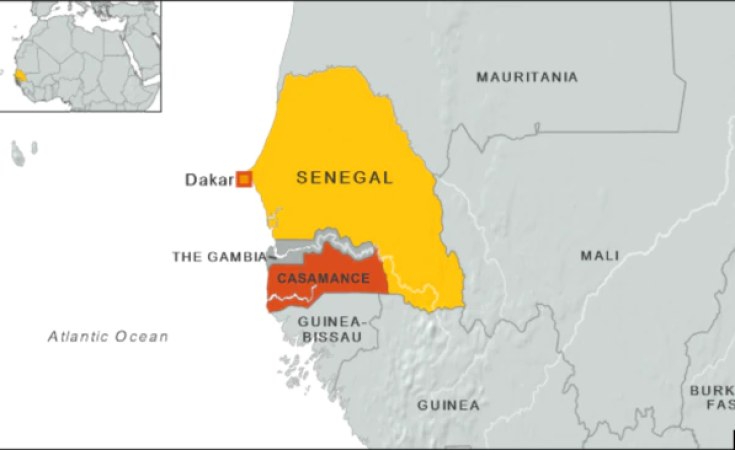To resolve the 42-year conflict once and for all, recent steps towards peace must be consolidated.
The socio-political crisis that began in 1982 in Casamance, southern Senegal, is the oldest armed conflict in West Africa. It pits the government against the Mouvement des forces démocratiques de Casamance (MFDC), an armed rebellion now divided into three main factions demanding independence for the region.
Significant progress has been made in resolving this conflict, particularly since 2012. That has allowed the state's security priorities to shift to eastern Senegal, a border area with Mali where violent extremist groups operate. But achieving a definitive resolution to the Casamance conflict requires a holistic approach that considers the different aspects of the crisis.
| Senegal's Casamance regionSource: ISS |
The government's strategy so far has fostered a positive peace dynamic. It combines negotiations with the MFDC factions and military pressure on the one hand, and socio-economic investment on the other.
Talks that began in 2020 between the government and the Diakaye faction led to a peace accord signed on 10 March 2023, and the laying down of arms in Mongone that May. In December 2023, 255 ex-MFDC combatants from the faction surrendered their weapons for incineration.
In 2021, Senegal's army attacked MFDC bases on the Guinea-Bissau border. A military operation in March 2022 targeted bases of the second faction led by Salif Sadio in the Bignona Department near The Gambia's border. Dismantling these bases and launching operations against timber and drug trafficking - the MFDC's main funding sources - helped weaken the various factions. In August 2022, the government signed a ceasefire agreement with César Atoute Badiate, leader of the third faction straddling southern Senegal and Guinea-Bissau.
These interventions were made possible by better resourcing of the defence and security forces, and military cooperation with The Gambia and Guinea-Bissau. Because of their geographical position, the two countries have served as rear bases for certain MFDC factions.
Former Gambian president Yahya Jammeh's departure from office in 2017 and Umaro Sissoco Embaló's 2020 accession to power in Guinea-Bissau gave Senegal's army the chance to deal with a movement weakened by leadership disputes and meagre local and external support.
Various investments by Senegal's government in Casamance have also helped resolve the conflict. The aim has been to create socio-economic and political conditions that encourage the gradual demobilisation of MFDC fighters.
Since 2012, the government has implemented a development policy dedicated to Casamance, and other fruitful initiatives to improve access for rural populations to basic infrastructure and social services, including in border areas. Overall, these are positive steps towards peace based on the region's economic development and the involvement of several players.
Notwithstanding the progress, disputes over leadership and negotiations with the government have been leading factors in dividing the MFDC and stalling the peace process. Just like the first ceasefire in 1991, the peace deals signed since 2022 have led to discord within the MFDC. This affected Sadio's faction based in Bignona, disrupting negotiations and preventing the signing of an agreement. Any resumption of dialogue must consider these dynamics.
The disarmament, demobilisation and reintegration (DDR) process initiated with the Diakaye faction was more successful than the DDR processes after the three ceasefire agreements (1991, 1993 and 1999) and two peace deals (2001 and 2004) signed with the MFDC. The DDR process is crucial for ongoing talks with other MFDC factions. Its effective implementation could secure peace and serve as a model for the various factions negotiating with the government.
Landmines are another serious threat that need attention. The explosives killed 870 people between 1988 and 2023 (610 civilians and 260 soldiers), according to Senegal's National Mine Action Centre (CNAMS). In the last recorded incident on 14 December 2023, a military vehicle hit an anti-tank mine in northern Bignona, killing four soldiers and wounding three others.
The CNAMS has cleared 2 063 992m² of land in the Ziguinchor, Sédhiou and Kolda regions. These demining operations must continue, particularly in the north of Bignona, along the border with Guinea-Bissau and, to a lesser extent, in the east of the Goudomp Department.
The lack of a comprehensive peace agreement with the MFDC, and the necessary financial and human resources, could prevent the government from eradicating landmines in accordance with the Ottawa Convention. The presence of mines not only impedes development programmes, but deters those displaced by the conflict from returning to set up income-generating activities.
Because of the demining and security operations, people are starting to repopulate some areas abandoned in the 1990s. Some government departments have provided support, but socio-economic reintegration and tensions linked to land and forest management will need to be attended to.
As the peace process shows positive momentum, these challenges must be tackled with urgency. Failure to do so could create tensions that might jeopardise the gains made.
Aissatou Kanté, Researcher, Littoral West African States, ISS Regional Office for West Africa, the Sahel and Lake Chad Basin
Paulin Maurice Toupane, Senior Researcher, Regional Office for West Africa, the Sahel and the Lake Chad Basin


